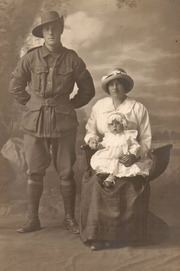Name Herbert Bolt | ||
 | ||
Herbert Thomas Bolt (1893–1916) was a pioneer Australian rugby league player, a state representative centre and soldier who served and fell in World War I. He is one of 75 Australian soldiers whose remains were identified by name in 2010 by the Commonwealth War Graves Commission as part of the Fromelles Military Cemetery project.
Contents
Rugby league career
Born and raised in Newtown, Sydney Bolt made 46 appearances(42 Premiership and 4 City Cup) for the Newtown Bluebags between 1912 and 1915. He represented New South Wales in all 4 matches on the 1913 tour of Queensland playing in the centres, scoring 2 tries in the first match against Queensland and being sent off in the second, he also played 2 minor matches on tour against Northern NSW in Newcastle & QLD Rugby Union Converts in Brisbane.
War service
Although married with a young baby daughter, Bolt enlisted in the 1st AIF in September 1915. He was working as a brickmaker at the time of his enlistment living at Bexley, south of Sydney. He left Australia on board HMAT A29 Suevic on 23 December 1915 as a member of the 7th reinforcement being sent to strengthen the 17th Battalion, 5th Brigade (Australia), 2nd Division.
On the arrival in Egypt in February 1916, Bolt was allotted to the 55th Battalion, 14th Brigade (New South Wales), 5th Division within II Anzac Corps. When the more experienced I Anzac Corps embarked for France at the end of the month, they took most of the available artillery pieces and trained personnel, leaving the II Anzac divisions to commence artillery training from scratch. Bolt was promoted to Corporal at the end of the training period. Although the 5th Division who began arriving in France in July were the last of the four Australian divisions from Egypt to do so, they would be the first to see major action on the Western Front at the Battle of Fromelles, just one week after going into the trenches.
Lieutenant-General Richard Haking, commander of the British XI Corps, which adjoined II Anzac Corps to the south, planned an attack to reduce the slight German salient known as the "Sugar Loaf", north west of the German-held town of Fromelles. The 5th Division happened to be the unit facing the northern flank of the salient. By the time the attack was ready to be launched, its purpose as a preliminary diversion to the main action at the Somme had passed, yet Haking and his army commander, General Sir Charles Monro, were keen to go ahead. At 6pm on 19 July, after 11 hours of preliminary bombardment, the 5th Division and British 61st Division attacked. The Australian 8th and 14th Brigades, attacking north of the salient, occupied the German trenches but became isolated and out-flanked.
The AIF Project quotes a statement taken from his friend Private Francis Johnston of the 55th Battalion who survived Fromelles but saw Bolt's demise. On the morning of 20 July 1916 at about 5am at Fleurbaix, Nutsy and I were close to one another when we were attacked by the Germans. He got more than six of them with his bayonet and the butt of his rifle, when he got a bullet through the head. He fell instantly being killed outright. He was as game as any man and was a well-known Newtown footballer
The battle was responsible for the greatest loss of Australian lives in one 24-hour period. The 5,533 Australian casualties, including 400 prisoners, were equivalent to the total Australian losses in the Boer War, Korean War and Vietnam War combined. It would be many months before the Australian 5th Division was serviceable again.
On the news of his death the Newtown club rallied to raise funds for his widow and child. Events included a fancy dress parade down King St, Newtown and then on to Erskineville Oval where a series of novelty events were held . With the money raised the club was able to purchase a house for Bolt's widow and daughter.
Bolt's remains were identified in 2010 as being lain in a forgotten mass grave at Pheasant Wood. Research by an Australian amateur historian, Lambis Englezos, had identified a site in a field at the edge of Bois Faisan on the outskirts of Fromelles. Bodies had been transported there by German soldiers on a narrow gauge trench railway on 22 July 1916, before being buried in eight pits measuring approximately 10 metres long, 2.2 metres wide and five metres deep. Englezos believed that these grave pits had not been discovered during the official post-war burial campaigns. After extensive archaeological surveys the mass grave was confirmed and remains were exhumed and tested against the DNA samples of the living relatives' of the fallen. Herbert Bolt's remains were reinterred in the Fromelles (Pheasant Wood) Military Cemetery in July 2010.
